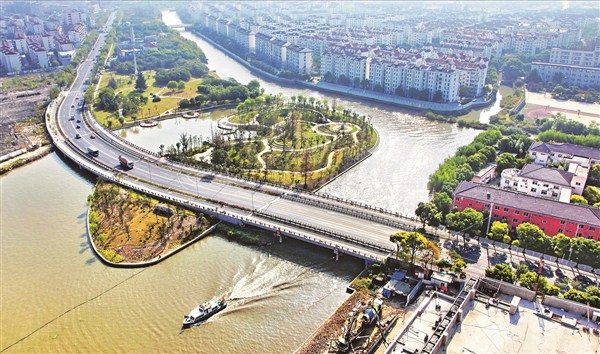今日上海
嘉定河流的故事 - 2017年01月06日
Flowing waters source of life and inspiration

WATER is the source of life and the foundation of city development. For thousands of years, water town Jiading has drawn visitors from all directions, thanks to its advantageous geographic location and abundant water resources.
There are over 4,300 river ways in Jiading District and most rural families lived by the riverside. Ponds can also be found in their yards. They used water for irrigation, aquaculture and transport.
A big part of the agricultural history of Jiading is about water control. The local government attached much importance to water conservancy construction in the past, projects mostly concentrating on the major rivers in the district — Wusong, Liuhe, Lianqi and Hengli rivers.
According to historical records, there were 170 water projects during Yuan (1271-1368), Ming (1368-1644) and Qing (1644-1911) dynasties in Jiading. Dredging was done every four years and required a tremendous amount of work.
Due to the massive task of water control in the Ming and Qing dynasties, a rule called fushu was implemented. It was in two parts — bianfu and bianshu. Bianfu means sending able-bodied men to work on water conservancy construction. Bianshu means collecting taxes to fund the conservancy projects.
Rivers flowing through Jiading
The total length of Jiading’s rivers are more than 1,800 kilometers and it has a water surface ratio of 7.71 percent. Following are the major waterways.
Yantiebang
Yantie literally means salt and iron. During the early Han Dynasty (BC 206-220 AD), Wu State (today in Jiangsu and Zhejiang provinces) was the fiefdom of Han’s Emperor Liu Bang’s nephew Liu Bi. At that time, salt-making was the main industry in Wu. To create a new route and deliver salt and iron for trading, Liu Bi asked his people to dig the Yantie River which connects Wusong River in the south and Yangtze River in the north. The river greatly promoted the development of local economy.
Wusong
This is an ancient river originating in Taihu Lake, flowing through Jingsu Province, Shanghai’s Qingpu, Songjiang and Jiangding districts, merging into the Huangpu River and finally emptying into the East China Sea. It has a total length of 125 kilometers and borders Jiading and Qingpu districts.
Gui Youguang, a government official and famous writer in the Ming Dynasty, compiled “Sanwu Shuili Lu,” a collection of articles on water conservancy in the Taihu Basin based on his field study and in-depth review of previous researches. This book analyzes the reasons for floods in the basin and puts forward specific measures of how to bring floods under control. According to Gui’s field studies, Wusong River plays an important role in flood control in the Taihu Lake Basin.
Liuhe
Liuhe River was called Lou River in the past. It is a tidal river and the sea water often poured backward which ruined the farming fields. Local farmers suffered a lot from the salty water until Qing Dynasty official Lin Zexu renovated the water gate and built a dam at the mouth of Liuhe River to keep out the saltwater. In 1823, Jiading was hit by continuous storms which caused severe flooding in the area. Lin ordered farmers to dredge Liuhe River to drain the water from the fields. The project helped local farmers sow wheat in time and ensured a good harvest the following year.
Lianqi
Lianqi River, known for its limpid water, is the mother river of Jiading. The 36-kilometer river flows east from Gupu in Jiading to the Caitao port in Baoshan and finally empties into the sea. Many poems have been composed by men of letters to illustrate the beauty of the spring scenery and the peace of daily life by Lianqi.
Hengli
According to experts, Hengli River is probably an artificial river built in the Tang Dynasty (618-907 AD) . Water conservancy facilities in Tang, which were used to regulate the water flow, can be found in the Hengli River Basin.
Wenzaobang
Water weeds are called wenzao in Jiading and the Wenzaobang flows from the Wusong River in Jiading to the Huangpu River in Baoshan. It has a total length of 34.64km, of which 17.94km are in Jiading. The Wencaobang basin was a strategic location during wars throughout history.
